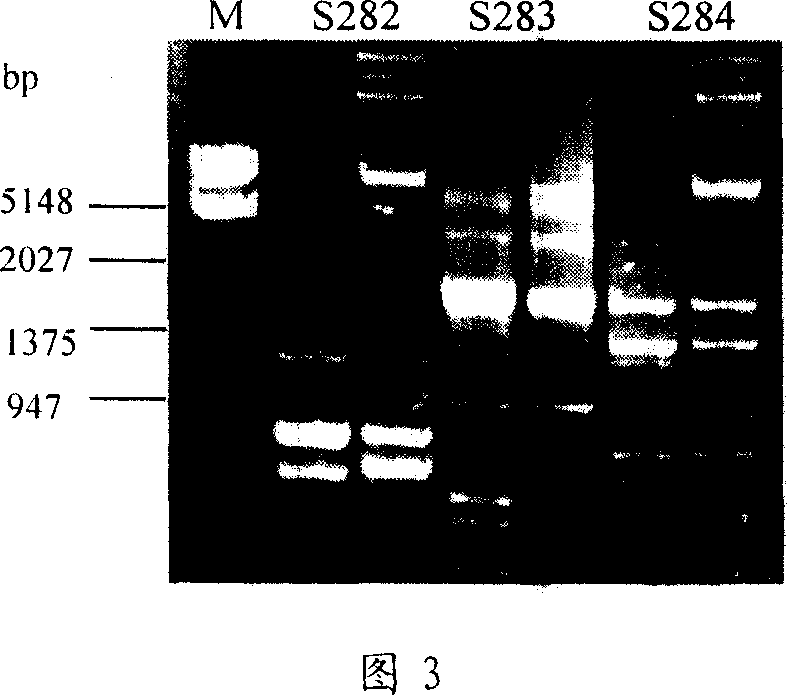Ultraviolet mutagenic obtained low temperature salina and its identifying method
An identification method and a low temperature-resistant technology, applied in the field of salina
- Summary
- Abstract
- Description
- Claims
- Application Information
AI Technical Summary
Problems solved by technology
Method used
Image
Examples
Embodiment 1
[0046] For ultraviolet mutagenesis and cultivation of low-temperature-resistant salt algae, it is necessary to prepare artificial seawater culture medium for cultivating Dunaliella bardawil, and divide the components into 50-1000 times mother liquid in advance, and then dilute it as needed to make culture liquid. . The composition of the artificial seawater culture solution for preparing Salina salina is shown in Table 1. The artificial seawater culture solution was divided into 100mL Erlenmeyer flasks, each containing 20mL, tightly plugged with cotton plugs, and wrapped with kraft paper. Place the packaged above-mentioned culture solution in an autoclave, and sterilize at 121° C. and a pressure of 0.1 mPa for 15 minutes. Take out the sterilized culture medium, cool it to room temperature, inoculate 1mL salina algae liquid into the sterile culture medium, shake it gently, and plug it with a cotton plug. In an incubator at 20°C, it was illuminated at 4000lx for 12h and dark f...
Embodiment 2
[0051] Similar to Example 1, the difference is that the artificial seawater culture solution for cultivating Dunaliella salina is prepared, the artificial seawater culture solution is divided into 250mL Erlenmeyer flasks, each bottle is filled with 50mL, sealed with 8 layers of gauze, and wrapped with kraft paper. Place the packaged above-mentioned culture solution in an autoclave, and sterilize at 121° C. and a pressure of 0.1 mPa for 20 minutes. Take out the sterilized culture medium, cool it to room temperature, inoculate 5mL salina algae liquid into the sterile culture medium, shake it gently, and seal it with 8 layers of gauze. In an incubator at 30°C, the light is 12h, 2000lx every day, and the darkness is 12h. Continuously cultured for 5 days to obtain synchronized growth of Salina salina, that is, a large number of cell divisions occurred in Salina salina from 6 hours after dark culture to 2 hours after light culture. Take out 0.5mL of the algae liquid regularly the ...
Embodiment 3
[0056] Similar to Example 1, the difference is that the artificial seawater culture solution for cultivating Dunaliella bardawil is prepared, the artificial seawater culture solution is divided into 150mL Erlenmeyer flasks, each bottle has a capacity of 30mL, the cotton plug is tightly plugged, and the kraft paper. Place the packaged above-mentioned culture solution in an autoclave, and sterilize at 121° C. and a pressure of 0.1 mPa for 15 minutes. Take out the sterilized culture medium, cool it down to room temperature, inoculate 3 mL of salina algae liquid into the sterile culture medium, shake it gently, and plug it with a cotton plug. In an incubator at 25°C, the light is 12h, 3000lx every day, and the darkness is 12h. Continuously cultured for 3 days to obtain synchronized growth of Salina salina, that is, a large number of cell divisions occurred in Salina salina from 6 hours after dark culture to 2 hours after light culture. Take out 5mL of the algae liquid regularly ...
PUM
 Login to View More
Login to View More Abstract
Description
Claims
Application Information
 Login to View More
Login to View More - R&D
- Intellectual Property
- Life Sciences
- Materials
- Tech Scout
- Unparalleled Data Quality
- Higher Quality Content
- 60% Fewer Hallucinations
Browse by: Latest US Patents, China's latest patents, Technical Efficacy Thesaurus, Application Domain, Technology Topic, Popular Technical Reports.
© 2025 PatSnap. All rights reserved.Legal|Privacy policy|Modern Slavery Act Transparency Statement|Sitemap|About US| Contact US: help@patsnap.com



